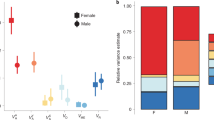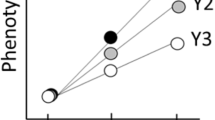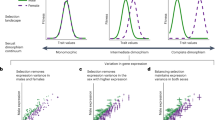Abstract
Sexually antagonistic selection arises when a trait expressed in both sexes (a shared trait) is selected towards different, sex-specific optima. Sex-discordant selection causes different alleles to be favoured in each sex (intralocus sexual conflict). A key parameter responsible for generating this conflict is the intersexual genetic correlation (rMF), which determines the degree to which heritable genetic variation for the shared trait produces a similar phenotype in both sexes. A strong, positive rMF interferes with adaptation when there is sex-discordant selection. In principle, the rMF can evolve in response to sex-discordant selection: the faster it declines, the faster the resolution of intralocus sexual conflict. Here, we use Drosophila melanogaster to quantify the time scale over which a strong, positive rMF impedes a response to sex-discordant selection for a canonical quantitative trait (body size) with an exceptionally long (250 generations) selection experiment for a complex multicellular organism. We found that, compared with rapid and substantial evolution under sex-concordant selection, a high rMF arrested sex-specific adaptation for 100 generations in females and a minimum of 250 generations in males. Our study demonstrates that a high rMF can lead to a protracted period of adaptive stalemate during the evolution of sexual dimorphism.
This is a preview of subscription content, access via your institution
Access options
Access Nature and 54 other Nature Portfolio journals
Get Nature+, our best-value online-access subscription
$29.99 / 30 days
cancel any time
Subscribe to this journal
Receive 12 digital issues and online access to articles
$119.00 per year
only $9.92 per issue
Buy this article
- Purchase on Springer Link
- Instant access to full article PDF
Prices may be subject to local taxes which are calculated during checkout




Similar content being viewed by others
References
Darwin, C. The Descent of Man and Selection in Relation to Sex (John Murray, London, 1888).
Lande, R. Sexual dimorphism, sexual selection, and adaptation in polygenic characters. Evolution 34, 292–305 (1980).
Arnqvist, G. & Rowe, L. Sexual Conflict (Princeton Univ. Press, Princeton, 2013).
Rice, W. R. Sex chromosomes and the evolution of sexual dimorphism. Evolution 38, 735–742 (1984).
Rice, W. R. Sexually antagonistic genes: experimental evidence. Science 256, 1436–1439 (1992).
Falconer, D. S., Mackay, T. F. & Frankham, R. Introduction to quantitative genetics (4th edn). Trends Genet. 12, 280 (1996).
Lynch, M. & Walsh, B. Genetics and Analysis of Quantitative Traits (Sinauer, Sunderland, 1998).
Bonduriansky, R. & Chenoweth, S. F. Intralocus sexual conflict. Trends Ecol. Evol. 24, 280–288 (2009).
Rice, W. R. & Chippindale, A. K. Intersexual ontogenetic conflict. J. Evol. Biol. 14, 685–693 (2001).
Poissant, J., Wilson, A. J. & Coltman, D. W. Sex‐specific genetic variance and the evolution of sexual dimorphism: a systematic review of cross‐sex genetic correlations. Evolution 64, 97–107 (2010).
Chippindale, A. K., Gibson, J. R. & Rice, W. R. Negative genetic correlation for adult fitness between sexes reveals ontogenetic conflict in Drosophila. Proc. Natl Acad. Sci. USA 98, 1671–1675 (2001).
Foerster, K. et al. Sexually antagonistic genetic variation for fitness in red deer. Nature 447, 1107–1110 (2007).
Brommer, J. E., Kirkpatrick, M., Qvarnström, A. & Gustafsson, L. The intersexual genetic correlation for lifetime fitness in the wild and its implications for sexual selection. PLoS ONE 2, e744 (2007).
Stewart, A. D., Pischedda, A. & Rice, W. R. Resolving intralocus sexual conflict: genetic mechanisms and time frame. J. Hered. 101, S94–S99 (2010).
Mank, J. E. Population genetics of sexual conflict in the genomic era. Nat. Rev. Genet. 18, 721–730 (2017).
Delph, L. F., Steven, J. C., Anderson, I. A., Herlihy, C. R. & Brodie, E. D. III Elimination of a genetic correlation between the sexes via artificial correlational selection. Evolution 65, 2872–2880 (2011).
Bonduriansky, R. & Rowe, L. Intralocus sexual conflict and the genetic architecture of sexually dimorphic traits in Prochyliza xanthostoma (Diptera: Piophilidae). Evolution 59, 1965–1975 (2005).
Griffin, R. M., Dean, R., Grace, J. L., Ryden, P. & Friberg, U. The shared genome is a pervasive constraint on the evolution of sex-biased gene expression. Mol. Biol. Evol. 30, 2168–2176 (2013).
Dean, R. & Mank, J. E. Tissue specificity and sex-specific regulatory variation permit the evolution of sex-biased gene expression. Am. Nat. 188, E74–E84 (2016).
Bird, M. A. & Schaffer, H. E. A study of the genetic basis of the sexual dimorphism for wing length in Drosophila melanogaster. Genetics 72, 475–487 (1972).
Allen, H. L. et al. Hundreds of variants clustered in genomic loci and biological pathways affect human height. Nature 467, 832–838 (2010).
Wood, A. R. et al. Defining the role of common variation in the genomic and biological architecture of adult human height. Nat. Genet. 46, 1173–1186 (2014).
Fisher, R. A. XV.—The correlation between relatives on the supposition of Mendelian inheritance. Earth Environ. Sci. Trans. R. Soc. Edinb. 52, 399–433 (1919).
Turner, T. L., Stewart, A. D., Fields, A. T., Rice, W. R. & Tarone, A. M. Population-based resequencing of experimentally evolved populations reveals the genetic basis of body size variation in Drosophila melanogaster. PLoS Genet. 7, e1001336 (2011).
Cowley, D. E., Atchley, W. R. & Rutledge, J. J. Quantitative genetics of Drosophila melanogaster. I. Sexual dimorphism in genetic parameters for wing traits. Genetics 114, 549–566 (1986).
Cowley, D. E. & Atchley, W. R. Quantitative genetics of Drosophila melanogaster. II. Heritabilities and genetic correlations between sexes for head and thorax traits. Genetics 119, 421–433 (1988).
Reeve, J. P. & Fairbairn, D. J. Sexual size dimorphism as a correlated response to selection on body size: an empirical test of the quantitative genetic model. Evolution 50, 1927–1938 (1996).
Peters, R. H. The Ecological Implications of Body Size (Cambridge Univ. Press, Cambridge, 1986).
Lefranc, A. & Bundgaard, J. The influence of male and female body size on copulation duration and fecundity in Drosophila melanogaster. Hereditas 132, 243–247 (2000).
Long, T. A. F., Pischedda, A., Stewart, A. D. & Rice, W. R. A cost of sexual attractiveness to high-fitness females. PLoS Biol. 7, e1000254 (2009).
Friberg, U. & Arnqvist, G. Fitness effects of female mate choice: preferred males are detrimental for Drosophila melanogaster females. J. Evol. Biol. 16, 797–811 (2003).
Dow, M. A. & von Schilcher, F. Aggression and mating success in Drosophila melanogaster. Nature 254, 511–512 (1975).
Ashburner, M. Drosophila. A Laboratory Handbook (Cold Spring Harbor Laboratory Press, Cold Spring Harbor, 1989).
Clutton-Brock, T. Sexual selection in males and females. Science 318, 1882–1885 (2007).
Kudo, A., Takamori, H., Watabe, H., Ishikawa, Y. & Matsuo, T. Variation in morphological and behavioraltraits among isofemale strains of Drosophila prolongata (Diptera: Drosophilidae). Èntomol. Sci 18, 221–229 (2015).
Setoguchi, S. et al. Sexual dimorphism and courtship behavior in Drosophila prolongata. J. Ethol. 32, 91–102 (2014).
Mathews, K. W., Cavegn, M. & Zwicky, M. Sexual dimorphism of body size is controlled by dosage of the X-chromosomal gene Myc and by the sex-determining gene tra in Drosophila. Genetics 205, 1215–1228 (2017).
Rideout, E. J., Narsaiya, M. S. & Grewal, S. S. The sex determination gene transformer regulates male–female differences in Drosophila body size. PLoS Genet. 11, e1005683 (2015).
Sawala, A. & Gould, A. P. The sex of specific neurons controls female body growth in Drosophila. PLoS Biol. 15, e2002252 (2017).
Ranz, J. M., Castillo-Davis, C. I., Meiklejohn, C. D. & Hartl, D. L. Sex-dependent gene expression and evolution of the Drosophila transcriptome. Science 300, 1742–1745 (2003).
Ayroles, J. F. et al. Systems genetics of complex traits in Drosophila melanogaster. Nat. Genet. 41, 299–307 (2009).
Mank, J. E. The transcriptional architecture of phenotypic dimorphism. Nat. Ecol. Evol. 1, 0006 (2017).
Robertson, F. W. & Reeve, E. Studies in quantitative inheritance. J. Genet. 50, 414–448 (1952).
Rice, W. R. et al. Inter-locus antagonistic coevolution as an engine of speciation: assessment with hemiclonal analysis. Proc. Natl Acad. Sci. USA 102, 6527–6534 (2005).
Kuijper, B. & Morrow, E. H. Direct observation of female mating frequency using time-lapse photography. Fly 3, 118–120 (2009).
Morrow, E. H., Stewart, A. D. & Rice, W. R. Patterns of sperm precedence are not affected by female mating history in Drosophila melanogaster. Evolution 59, 2608–2615 (2005).
Acknowledgements
Funding during the early part of this study was provided by the NSF (DEB-0128780 and DEB-0410112) and NIH (1R01HD057974-01). Canisius College provided funding during the later parts of the study. We thank A. Pischedda, P. Miller and numerous undergraduate researchers at UCSB and Canisius College for assistance with the body size assays, and U. Frieberg and A. Pischedda for comments on earlier drafts of the manuscript.
Author information
Authors and Affiliations
Contributions
The idea for this study originated from discussions between A.D.S. and W.R.R. A.D.S conducted the experiments. A.D.S. and W.R.R. conducted the data analyses and drafted the manuscript.
Corresponding author
Ethics declarations
Competing interests
The authors declare no competing interests.
Additional information
Publisher’s note: Springer Nature remains neutral with regard to jurisdictional claims in published maps and institutional affiliations.
Integrated supplementary information
Supplementary information
Supplementary information
Supplementary Figure 1
Rights and permissions
About this article
Cite this article
Stewart, A.D., Rice, W.R. Arrest of sex-specific adaptation during the evolution of sexual dimorphism in Drosophila. Nat Ecol Evol 2, 1507–1513 (2018). https://doi.org/10.1038/s41559-018-0613-4
Received:
Accepted:
Published:
Issue Date:
DOI: https://doi.org/10.1038/s41559-018-0613-4
This article is cited by
-
Gene-poor Y-chromosomes substantially impact male trait heritabilities and may help shape sexually dimorphic evolution
Heredity (2023)
-
Evolutionary genomics of camouflage innovation in the orchid mantis
Nature Communications (2023)
-
Rapid evolution of sexual size dimorphism facilitated by Y-linked genetic variance
Nature Ecology & Evolution (2021)



